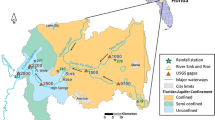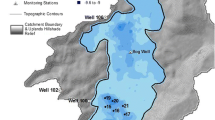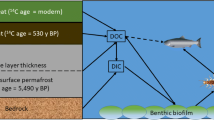Abstract
Monitoring data over the period 1994–2007 were analysed for three streams (Cottage Hill Sike, CHS; Rough Sike, RS; Trout Beck, TB) draining blanket peat underlain by glacial clay and limestone-rich sub-strata at Moor House (Northern England). Dissolved organic carbon concentration, [DOC], showed complex relationships with both discharge and calcium concentration, [Ca]. A model based on [Ca] was constructed to simulate stream [DOC] by mixing dissolved organic matter (DOM) from shallow peat, quantified by measured [DOC] (15–30 mg l−1) in peat porewater, with DOM assumed to be present at a constant concentration (c. 5 mg l−1) in groundwater. A temperature-based adjustment to the measured porewater [DOC] was required to account for relatively low streamwater [DOC] during winter and spring. The fitted model reproduced short-term variation in streamwater [DOC] satisfactorily, in particular variability in RS and TB due to groundwater contributions. Streamwater DOM is largely derived from surface peat, which accounts for more than 96% of the total DOC flux in both RS and TB, and 100% in CHS. Model outputs were combined with streamwater and porewater DO14C data to estimate the 14C contents, and thereby the ages, of DOM from peat and groundwater. The peat-derived DOM is 5 years old on average, with most of it very recently formed. The derived age of groundwater DOM (8,500 years) is comparable to the 4,000–7,000 years estimated from the DO14C of water extracts of clay underlying the peat, suggesting that the clay is the source of groundwater DOM.








Similar content being viewed by others
References
Amundson R (2001) The carbon budget in soils. Annu Rev Earth Planet Sci 29:535–562
Benner R, Benitez-Nelson B, Amon RMW (2004) Export of young terrigenous dissolved organic carbon from rivers to the Arctic Ocean. Geophys Res Lett 31. doi:10.1029/2003GL019251
Billett MF, Palmer SM, Hope D, Deacon C, Storeton-West R, Hargreaves KJ, Flechard C, Fowler D (2004) Linking land-atmosphere-stream carbon fluxes. Global Biogeochem Cycles 18: GB1024. doi:10.1029/2003GB002058
Billett MF, Deacon C, Palmer SM, Dawson JJC, Hope D (2006) Connecting organic carbon in streamwater and soils in a peatland catchment. J Geophys Res—Biogeosci 111:GO2010. doi:10.1029/2005JG000065
Billett MF, Garnett MH, Harvey F (2007) UK peatland streams release old carbon dioxide to the atmosphere and young dissolved organic carbon to rivers. Geophys Res Lett 34:L23401. doi:10.1029/2007GL031797
Buckingham S, Tipping E, Hamilton-Taylor J (2008) Dissolved organic carbon in soil solutions: a comparison of collection methods. Soil Use Manage 24:29–36
Clark JM, Chapman PJ, Adamson JK, Lane SM (2005) Influence of drought-induced acidification on the mobility of dissolved organic carbon in peat soils. Global Change Biol 11:791–809
Clark JM, Lane SM, Chapman PJ, Adamson JK (2007) Export of dissolved organic carbon from an upland peatland during storm events: implications for flux estimates. J Hydrol 347:438–447
Clark JM, Lane SM, Chapman PJ, Adamson JK (2008) Link between DOC in near surface peat and stream water in an upland catchment. Sci Total Environ 404:308–315
Crisp DT (1966) Input and output of minerals for an area of Pennine moorland: the importance of precipitation, drainage, peat erosion and animals. J Appl Ecol 3:327–348
Dawson JJC, Bakewell C, Billett MF (2001) Is in-stream processing an important control on spatial changes in headwater carbon fluxes? Sci Total Environ 265:153–167
Dawson JJC, Billett MF, Neal C, Hill S (2002) A comparison of particulate, dissolved and gaseous carbon in two contrasting upland streams in the UK. J Hydrol 257:226–246
Evans MG, Burt TP, Holden J, Adamson JK (1999) Runoff generation and water table fluctuations in blanket peat: evidence from UK data spanning the dry summer of 1995. J Hydrol 221:141–160
Evans CD, Chapman PJ, Clark JM, Monteith DT, Cressser MS (2006) Alternative explanations for rising dissolved organic carbon export from organic soils. Global Change Biol 12:2044–2053
Evans CD, Freeman C, Cork LG, Thomas DN, Reynolds B, Billett MF, Garnett MH, Norris D (2007) Evidence against recent climate-induced destabilisation of soil carbon from C-14 analysis of riverine dissolved organic matter. Geophys Res Lett 34. doi:10.1029/2007GL029431
Fenner N, Ostle NJ, McNamara N, Sparks T, Harmens H, Reynolds B, Freeman C (2007) Elevated CO2 effects on peatland plant community carbon dynamics and DOC production. Ecosystems 10:635–647
Freeman C, Ostle N, Kang H (2001a) An enzymic ‘latch’ on a global carbon store—a shortage of oxygen locks up carbon in peatlands by restraining a single enzyme. Nature 409:149
Freeman C, Evans CD, Monteith DT, Reynolds B, Fenner N (2001b) Export of organic carbon from peat soils. Nature 412:785
Freeman C, Fenner N, Ostle NJ, Kang H, Dowrick DJ, Reynolds B, Lock MA, Sleep D, Hughes S, Hudson J (2004) Export of dissolved organic carbon from peatlands under elevated carbon dioxide levels. Nature 430:195–198
Fröberg M, Jardine PM, Hanson PJ, Swanston CW, Todd DE, Tarver JR, Garten CT (2007) Low dissolved organic carbon input from fresh litter to deep mineral soils. Soil Sci Soc Am J 71:347–354
Heal OW, Smith R (1978) The Moor House Programme: introduction and site description. In: Heal OW, Perkins DF (eds) Production ecology of British Moors and Montane grasslands. Springer, Berlin, pp 3–16
Helsel DR, Mueller DK, Slack JR (2006) Computer program for the Kendall family of trend tests: U.S. Geological Survey Scientific Investigations Report 2005-5275
Hessen DO, Tranvik LJ (1998) Aquatic humic substances. Springer, Berlin
Holden J, Adamson JK (2001) Gordon Manley and the north Pennines. J Meteorol 26:329–333
Holden J, Burt TP (2003a) Runoff production in blanket peat covered catchments. Water Resour Res 39: doi:10.1029/2002WR001956
Holden J, Burt TP (2003b) Hydrological studies on blanket peat: the significance of the acrotelm-catotelm model. J Ecol 91:86–102
Hua Q, Barbetti M (2004) Review of tropospheric bomb C-14 data for carbon cycle modeling and age calibration purposes. Radiocarbon 46:1273–1298
Johnson GAL, Dunham KC (1963) The geology of Moor House. Her Majesty’s Stationery Office, London
Jones HE, Gore AJP (1978) A simulation of production and decay in blanket bog. In: Heal OW, Perkins DF (eds) Production ecology of British moors and montane grasslands. Springer, Berlin, pp 160–186
Kullberg A, Bishop KH, Hargeby A, Jansson M, Petersen RC (1993) The ecological significance of dissolved organic carbon in acidified waters. Ambio 22:331–337
Lawrence H, Vincent K, Smith M, Colbeck C, Tang YS, Sutton MA, Simmons I, Love L, Vogt E, van Dijk N, Cape JN, Smith RI (2007) UK Acid Deposition Monitoring Network: Data Summary 2006. Report to the Department for Environment, Food and Rural Affairs and the Devolved Regions, AEA Energy and Environment, Harwell, 190 pp
Levin I, Kromer B (2004) The tropospheric 14CO2 level in mid-latitudes of the Northern Hemisphere (1959–2003). Radiocarbon 46:1261–1272
Meyer JL, Tate CM, Edwards RT, Crocker MT (1988) The trophic significance of dissolved organic carbon in streams. In: Swank WT, Crossley DA (eds) Forest hydrology and ecology at Coweeta. Springer, New York, pp 269–278
Monteith DT, Stoddard JL, Evans CD, de Wit HA, Forsius M, Høgåsen T, Wilander A, Skjelkvåle BL, Jeffries DS, Vuorenmaa J, Keller B, Kopácek J, Vesely J (2007) Dissolved organic carbon trends resulting from changes in atmospheric deposition chemistry. Nature 450:537–541
Neff JC, Finlay JC, Zimov SA, Davydov SP, Carrasco JJ, Schuur EAG, Davydova AI (2006) Seasonal changes in the age and structure of dissolved organic carbon in Siberian rivers and streams. Geophys Res Lett 33. doi:10.1029/2006GL028222
Opsahl S, Benner R, Amon RMW (1999) Major flux of terrigenous dissolved organic matter through the Arctic Ocean. Limnol Oceanogr 44:2017–2023
Palmer SM, Hope D, Billett MF, Dawson JC, Bryant CL (2001) Sources of organic and inorganic carbon in a headwater stream: evidence from carbon isotope studies. Biogeochemistry 52:321–338
Perdue EM, Gjessing ET (1990) Organic acids in aquatic ecosystems. Wiley, New York
Raymond PA, McClelland JW, Holmes RM, Zhulidov AV, Mull K, Peterson BJ, Striegl RG, Aiken GR, Gurtovaya TY (2007) Flux and age of dissolved organic carbon exported to the Arctic Ocean: a carbon isotopic study of the five largest artic rivers. Glob Biogeochem Cycles 21: GB4011. doi:10.1029/2007GB002934
Roulet N, Lafleur PM, Richard PJH, Moore TR, Humphreys ER, Bubier J (2007) Contemporary carbon balance and late Holocene carbon accumulation in a northern peatland. Glob Chang Biol 13:397–411
Schiff SL, Aravena R, Trumbore SE, Hinton MJ, Elgood R, Dillon PJ (1997) Export of DOC from forested catchments on the Precambrian Shield of Central Ontario: clues from 13C and 14C. Biogeochemistry 36:43–65
Stuiver M, Polach HA (1977) Discussion: reporting of 14C data. Radiocarbon 19:355–363
Tipping E, Smith EJ, Bryant CL, Adamson JK (2007) The organic carbon dynamics of a moorland catchment in N.W. England. Biogeochemistry 84:171–189
Worrall F, Burt T (2005) Predicting the future DOC flux from upland peat catchments. J Hydrol 300:126–139
Worrall F, Burt TP, Jaeban RY, Warburton J, Shedden R (2002) Release of dissolved organic carbon from upland peat. Hydrol Proc 16:3487–3504
Worrall F, Burt TP, Adamson J (2003) Controls on the chemistry of runoff from an upland peat catchment. Hydrol Proc 17:2063–2083
Worrall F, Harriman R, Evans CD, Watts CD, Adamson JK, Neal C, Tipping E, Burt T, Grieve IC, Montieth D, Naden PS, Nisbet T, Reynolds B, Stevens P (2004) Trends in dissolved organic carbon in UK rivers and lakes. Biogeochemistry 70:369–402
Worrall F, Burt TP, Adamson J (2006) The rate of and controls upon DOC loss in a peat catchment. J Hydrol 321:311–325
Acknowledgements
We are grateful to B. Dodd, E.J. Smith and J. Antelo for help with sampling, and to J.K. Adamson and P. Chamberlain (CEH) for advice and helpful discussions. Thanks are due to Natural England for allowing us to use the field site, and the UK Natural Environment Research Council for funding this work. The isotope data were funded by NERC via the NERC Radiocarbon Facility (Environment) from allocations 905.0501, 1110.0405 and 1215.0407. We thank F. Hagedorn and two anonymous referees for their constructive comments on the manuscsript.
Author information
Authors and Affiliations
Corresponding author
Rights and permissions
About this article
Cite this article
Tipping, E., Billett, M.F., Bryant, C.L. et al. Sources and ages of dissolved organic matter in peatland streams: evidence from chemistry mixture modelling and radiocarbon data. Biogeochemistry 100, 121–137 (2010). https://doi.org/10.1007/s10533-010-9409-6
Received:
Accepted:
Published:
Issue Date:
DOI: https://doi.org/10.1007/s10533-010-9409-6




